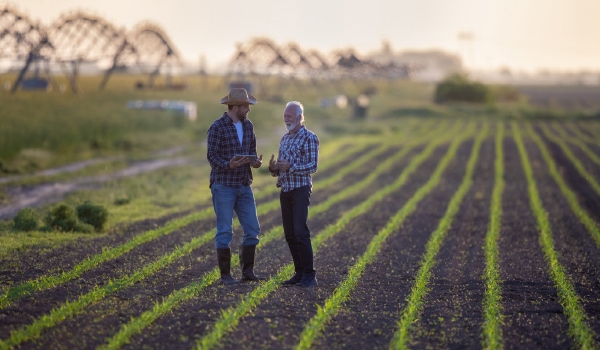VERTICAL FOCUS: Agriculture/Bulk Agriculture Commodities

AG Outlook: Mixed
Both clear skies and stormy weather are in the forecast for the agricultural sector. That’s the mixed-bag conclusion from a September 2022 panel discussion at the Ag Outlook Forum in Kansas City, Missouri.
The panel of experts—including Kip Tom, former ambassador to the U.N. Food & Agriculture Organization, and Daniel Whitley, administrator for USDA’s Foreign Agricultural Service—stated that U.S. farmers right now are in a good economic position. Both incomes and land values are far higher now than they were before the pandemic, they noted.
The group pointed to ongoing macro-economic challenges and impact from the war in Ukraine as factors that are wreaking havoc on supply chains and putting increasing expectations on U.S. farmers to increase production of crops such as wheat.
They expect supply chain challenges—a backlog of agricultural equipment and parts, manufacturing disruptions stemming from China’s continued zero-COVID policies, and the potentially fragile energy situation in Europe as a result of the Russia-Ukraine conflict.
Agricultural labor is another potential disturbance. A glut of unfilled jobs in the dairy industry is particularly worrisome, the panel noted.
Food Commodity Prices Dropping—But Still Inflated
The latest Food Price Index, released in September 2022 by the UN Food and Agriculture Organization (FAO), shows that the prices of five key commodities—cereals, vegetable oil, dairy, meat, and sugar—have fallen for a fifth consecutive month. The good news is tempered by the fact that prices are still nearly 8% higher than they were one year ago.
The Index, which tracks the monthly international prices of these breadbasket staples, averaged 138 points in August, down nearly 2% from July, though 7.9% above the value one year before. Here’s a breakdown:
- Cereal: A landmark agreement in July 2022 that unblocked Ukraine grain exports amid the ongoing war has helped to lower cereal prices. Production expectations are still tight, however: FAO’s global cereal production forecast projects a decline of nearly 40 million metric tons, or 1.4% from the previous year.
- Cheese: Although dairy prices saw a 2% drop, they remained 23.5% higher than in August 2021. The price of cheese increased for the 10th consecutive month.
- Meat: The price of meat declined by 1.5% but remained just over 8% higher than the value last August. Meat prices declined due to weak domestic demand in some top exporting countries, the report notes.
- Sugar: Sugar prices hit their lowest level since July 2021, largely due to high export caps in India and lower ethanol prices in Brazil.
- Vegetable oil: Prices decreased by 3.3%, which is slightly below the August 2021 level. FAO attributes this to increased availability of palm oil from Indonesia and the resumption of sunflower oil shipments from Ukraine.
Much Ado About Cotton
The world’s most widely used natural fiber for clothing, cotton is a key agricultural staple around the globe. As such, the twists and turns in its pricing tell an important economic story. After a super-high peak in spring 2022, cotton prices dropped significantly, according to the September 2022 USDA report. A variety of factors, including demand, harvest conditions, and the value of the U.S. dollar all come into play.
Key highlights from the USDA’s most recent data include:
- Cotton futures shed 25% since late August.
- The most actively traded futures ended the month at 88 cents a pound, down more than 40% from May’s peak of 140 cents per pound, which was the highest price in more than a decade. (Also worth noting: Cotton prices have only exceeded $1 a pound three times since the late 1950s.)
- One factor driving the cotton price drop is negative forecasts from clothing manufacturers, who cite concerns over high energy costs and waning consumer demand.
- Another reason: Analysts believe inflation will drive consumers to focus their spending on essential items, leading to a decrease in clothing purchases.
- Drought is also an issue. The U.S. cotton crop has been hard-hit by dry weather over the growing season, causing supply worries, which impact prices.
Green Snapshot: ScottsMiracle-Gro
North America’s leading recycler of compost, ScottsMiracle-Gro, redirects green waste into its products to support the concept of circularity. Doing so prevents green waste, such as grass and tree trimmings and waste from commercial landscaping, tree cultivation, and agriculture, from ending up in landfills. The company also supports a “growing local” strategy, counting on a network of small and mid-size companies as agricultural partners.
The result? A bag of ScottsMiracle-Gro soil is sourced, produced, and used within a 120-mile radius on average. And, the company recycles roughly 9 billion pounds of green waste each year.
Moving Fertilizer Production Forward
The U.S. Department of Agriculture recently announced $500 million in federal grants under The Fertilizer Production Expansion Program, part of a government effort to promote competition in agricultural markets. The funds are being made available through the Commodity Credit Corporation and will be used to support independent, innovative, and sustainable American fertilizer production to supply American farmers.
Funds also will expand the manufacturing and processing of fertilizer and nutrient alternatives in the United States and its territories.
The program will support fertilizer production that is:
- Independent, and outside the orbit of dominant fertilizer suppliers. Because the program’s goal is to increase competition, market share restrictions apply.
- Made in America. Products must be produced by companies operating in the U.S. or its territories, to create good-paying jobs at home, and reduce the reliance on potentially unstable, inconsistent foreign supplies.
- Innovative. Techniques will improve fertilizer production methods and efficient-use technologies to jumpstart the next generation of fertilizers and nutrient alternatives.
- Sustainable. Ideally, products will reduce the greenhouse gas impact of transportation, production, and use through renewable energy sources, feedstocks, and formulations, incentivizing greater precision in fertilizer use.
- Farmer-focused. Like other Commodity Credit Corporation investments, a driving factor is providing support and opportunities for U.S. agricultural commodity producers.
